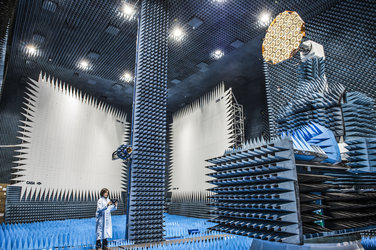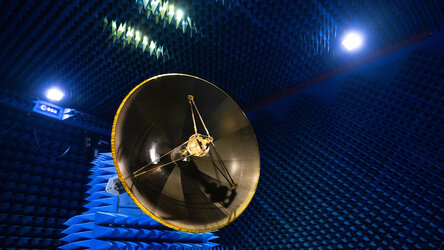Accept all cookies Accept only essential cookies See our Cookie Notice

About ESA
The European Space Agency (ESA) is Europe’s gateway to space. Its mission is to shape the development of Europe’s space capability and ensure that investment in space continues to deliver benefits to the citizens of Europe and the world.
Highlights
ESA - United space in Europe
This is ESA ESA facts Member States & Cooperating States Funding Director General Top management For Member State Delegations European vision European Space Policy ESA & EU Space Councils Responsibility & Sustainability Annual Report Calendar of meetings Corporate newsEstablishments & sites
ESA Headquarters ESA ESTEC ESA ESOC ESA ESRIN ESA EAC ESA ESAC Europe's Spaceport ESA ESEC ESA ECSAT Brussels Office Washington OfficeWorking with ESA
Business with ESA ESA Commercialisation Gateway Law at ESA Careers Cyber resilience at ESA IT at ESA Newsroom Partnerships Merchandising Licence Education Open Space Innovation Platform Integrity and Reporting Administrative Tribunal Health and SafetyMore about ESA
History ESA Historical Archives Exhibitions Publications Art & Culture ESA Merchandise Kids Diversity ESA Brand CentreLatest
Space in Member States
Find out more about space activities in our 23 Member States, and understand how ESA works together with their national agencies, institutions and organisations.
Science & Exploration
Exploring our Solar System and unlocking the secrets of the Universe
Go to topicAstronauts
Missions
Juice Euclid Webb Solar Orbiter BepiColombo Gaia ExoMars Cheops Exoplanet missions More missionsActivities
International Space Station Orion service module Gateway Concordia Caves & Pangaea BenefitsLatest
Space Safety
Protecting life and infrastructure on Earth and in orbit
Go to topicAsteroids
Asteroids and Planetary Defence Asteroid danger explained Flyeye telescope: asteroid detection Hera mission: asteroid deflection Near-Earth Object Coordination CentreSpace junk
About space debris Space debris by the numbers Space Environment Report In space refuelling, refurbishing and removingSafety from space
Clean Space ecodesign Zero Debris Technologies Space for Earth Supporting Sustainable DevelopmentLatest
Applications
Using space to benefit citizens and meet future challenges on Earth
Go to topicObserving the Earth
Observing the Earth Future EO Copernicus Meteorology Space for our climate Satellite missionsCommercialisation
ESA Commercialisation Gateway Open Space Innovation Platform Business Incubation ESA Space SolutionsLatest
Enabling & Support
Making space accessible and developing the technologies for the future
Go to topicBuilding missions
Space Engineering and Technology Test centre Laboratories Concurrent Design Facility Preparing for the future Shaping the Future Discovery and Preparation Advanced Concepts TeamSpace transportation
Space Transportation Ariane Vega Space Rider Future space transportation Boost! Europe's Spaceport Launches from Europe's Spaceport from 2012Latest

Discharge test for launcher antenna
Thank you for liking
You have already liked this page, you can only like it once!
Keeping a launcher in flight connected with the ground is one of the toughest jobs an antenna can have. Having to contend with high temperatures, vibration and atmospheric slipstream is hard enough, but shifting atmospheric pressure levels as the launcher heads into the vacuum of space (and potentially back again) can risk dangerous electrical discharges called corona – being tested for here.
The antenna design being tested at ESA’s High Power Radio Frequency Laboratory in Valencia, Spain, is one of a quartet that is about to see service on Spain’s Miura 1 sub-orbital micro-launcher, developed by the PLD Space company. But the four antennas are also undergoing a separate test campaign to qualify them for wider future uses.
“There are four different antenna types in all, each being flown in pairs aboard Miura 1,” explains ESA antenna engineer Victoria Iza.
“One is a Global Navigation Satellite Signal antenna, using satellite navigation signals to track the launcher’s position; one is an S-band antenna to transmit telemetry plus C-band and UHF antennas that both serve the security system that will end the flight safely in case of malfunction, operating on a redundant basis.
“Built by Spain’s Anteral company, this quartet of conformal dielectric antennas – each roughly the size of a smartphone and made to fit around the hull of the upper stage – has already been qualified as part of the avionics bay of the Miura 1. But with the number of European small launchers increasing rapidly, supported by ESA’s Boost! programme, the potential is there for these antennas to find wider uses, so they are being put through a separate qualification programme.”
Taking place through ESA’s General Support Technology Programme, helping develop promising new products for space and the open market, the antennas are currently undergoing environmental testing including thermal vacuum where they are exposed to sustained vacuum and temperature extremes – and vibration tests.
These antennas have to sustain harsh thermomechanical environments during launch, orbital flight and eventual return to Earth, so the project has been supported on the ESA side by structures engineer Goncalo Rodrigues and thermal engineer Miguel Copano.
Key stress factors are vibrations propagating from the launch vehicle jet engines, shocks resulting from the fairing and stages separation and the extreme temperatures resulting from aerothermal fluxes and – once in orbit – alternating Sun and cold space exposure.
To check the antennas designs can not only survive but go on operating as intended, the team employed a combination of computer simulations and on-ground test facilities including electro-magnetic shakers, pyro-shock tables and thermal-vacuum chambers.
“Most of the testing has been carried out at the Public University of Navarra, UPNA, but ESA’s High Power Radio Frequency Lab was used for corona discharge testing,” adds Victoria.
“When a radio frequency antenna is surrounded by a vestigial amount of atmosphere – as when a launcher is either leaving or returning to a planetary atmosphere – then there is the potential for this air to become ionised by the radio signal, risking damaging lightning-like discharge.
“The antennas were placed in this glass container so that their surrounding air levels can be changed while the antennas are in operation; the glass does not impede the radio signals. Our full test campaign will conclude soon, hopefully helping the antennas to find fresh markets, not only for launchers – for instance, their demonstrated robustness means they could also be used aboard planetary landers.”
"For Anteral, the development of these antennas is key to our positioning in the small launcher market,” explains Fernando Teberio, Chief Technology Officer of Anteral.
Anteral CEO Itziar Maestrojuan notes: “Thanks to the support from ESA we have been able to fully qualify the antennas that will be used on Miura-1 and hopefully on many other launchers and different applications where reliability is a key parameter.”
-
CREDIT
Anteral -
LICENCE
ESA Standard Licence

Sound test of Hera asteroid mission antenna

Testing antenna coating

Hybrid European RF and Antenna Test Zone

Large antenna deployment















 Germany
Germany
 Austria
Austria
 Belgium
Belgium
 Denmark
Denmark
 Spain
Spain
 Estonia
Estonia
 Finland
Finland
 France
France
 Greece
Greece
 Hungary
Hungary
 Ireland
Ireland
 Italy
Italy
 Luxembourg
Luxembourg
 Norway
Norway
 The Netherlands
The Netherlands
 Poland
Poland
 Portugal
Portugal
 Czechia
Czechia
 Romania
Romania
 United Kingdom
United Kingdom
 Slovenia
Slovenia
 Sweden
Sweden
 Switzerland
Switzerland

























